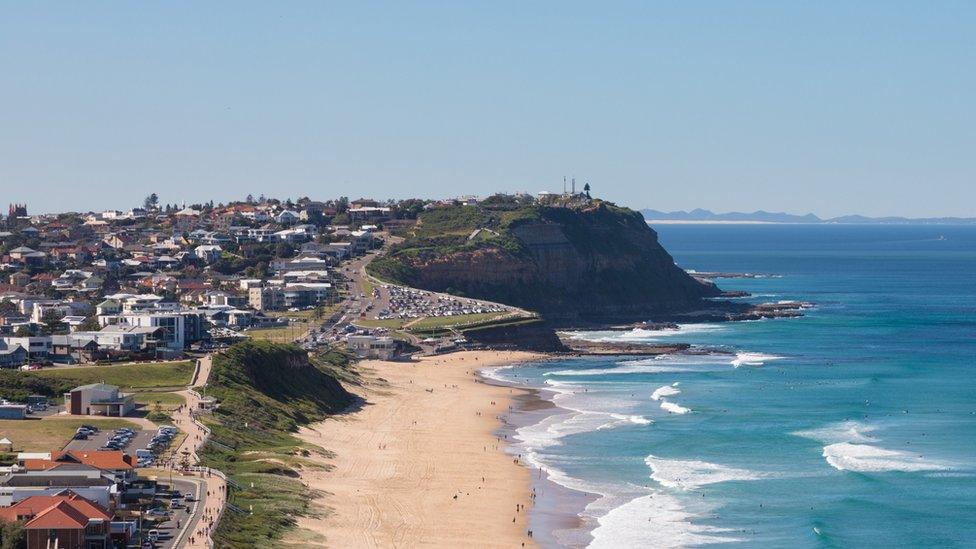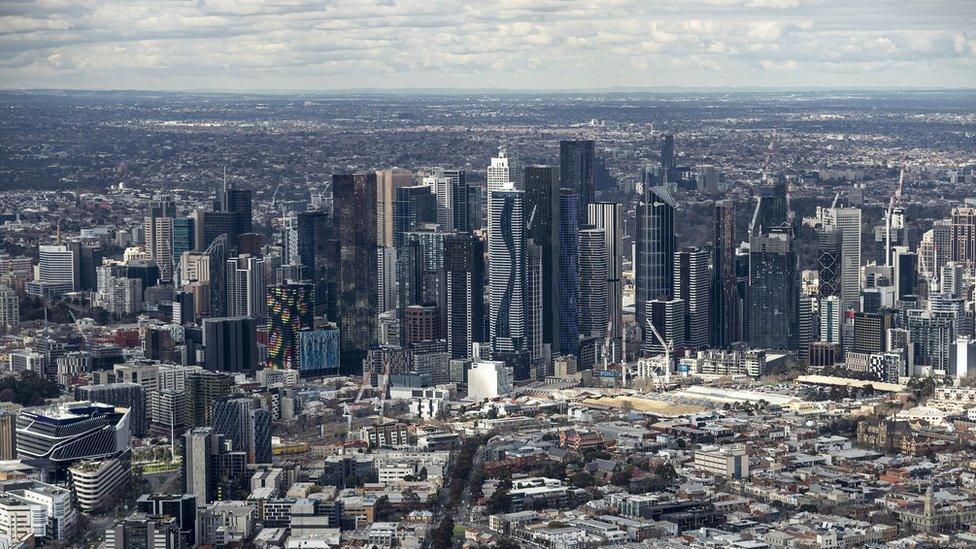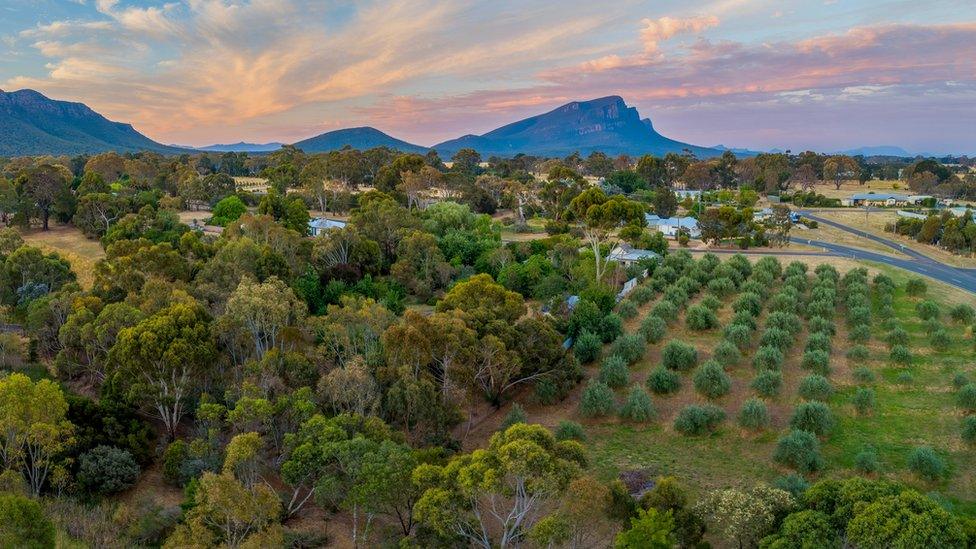Have Australians fallen out of love with Sydney and Melbourne?
- Published

Some Australians are moving out of Sydney and Melbourne in search of a better quality of life
Australians take their lifestyles seriously, so could coronavirus-induced flexibility change their living preferences forever?
We Australians live in an enviable country - white-sand beaches, rugged mountain ranges, and a sparse and stunning outback.
Yet though many Aussies have long dreamt of living by the seaside, or in a quaint rural town, large employment hubs in urban areas like Sydney and Melbourne have tied a significant portion of the population to the inland suburbs of the largest cities. Until the pandemic that is.
In addition to all the troubles and sadness, coronavirus has changed the way many of us work, largely due to the mainstream adoption of home-working that looks set to continue once the pandemic is finally over.
This means that for some - notably wealthier white-collar workers who have the option to work remotely - they can leave the busy and expensive large cities, and move somewhere much quieter and cheaper in pursuit of a better lifestyle.

Newcastle Australia, pictured, has some great beaches, and while Sydney does too, Newcastle is cheaper and quieter
Data shows that Australians are already on the move. Sales volumes in regional Australia surged 20% in 2020, a new report by property-selling website www.realestate.com.au has shown, external. This was double the growth seen in the state capitals, and the study said that Covid-19 was "driving a lifestyle shift".
A separate report said that in the 12 months to the end of January house prices across regional Australia surged by 40%, "more than three times the pace of capital cities", external.
"The areas with the largest increases in sales over the past year were dominated by regional markets and outer capital city areas," says Cameron Kusher, director of economic research at REA Group, which owns realestate.com.au.
"This highlights a shift in population - perhaps driven by the prevalence of working from home and lifestyle changes."
Nathan Stribley, a city planner at business consultancy Urbis, says that coronavirus has "turbocharged" exciting trends in Australia.
"Working from home was something that was happening pre-Covid, but there's no doubt that the impact of Covid, and the restrictions on accessing CBDs [central business districts] and getting to work, has been a revolution in terms of the number of businesses that have moved to the technological enablement of offsite work," he says.
"That greater flexibility has freed people up to make decisions about where they want to locate, how often they need to be in the office, and how far they're willing to commute."
This line of thinking applied to Brooke Moyle, a creative producer and stylist, who recently uprooted her life in inner Sydney, and moved with her husband and young daughter to Newcastle - a smaller coastal city two hours' drive away.

Brooke Moyle, her partner and daughter, have moved to Newcastle
Ms Moyle now plans to commute to Sydney just one day per week. "Covid was a deciding factor for us," says the 31-year-old. "It changed the way we lived and worked. And, I guess, as frustrating and hard as Covid has been, it's actually allowed us to rethink where we work and how we work."
For Tania Bellofiore, 36, and her husband, it made sense to leave the Melbourne suburb of Mulgrave during Covid, to live in their former holiday rental on Phillip Island, a two-hour drive from Melbourne's CBD, while Ms Bellofiore was on maternity leave.
This was planned to be a temporary move, but the couple are now considering making their coastal relocation permanent. "We've come to love the unhurried pace and small community feeling of Phillip Island, and we're close enough to the city to commute as needed," says Ms Bellofiore.
"Sometimes it's hard to imagine going back to the busy city lifestyle, especially with a young family."
For others, a fundamental shift in the way business is conducted has disentangled them from city life entirely. Glen Carlson, who offers business advisory and consultancy services through his company Dent Global, has had flexible working arrangements in place with his staff since 2017.
However, client expectations meant he and his team needed to be based in a major city for workshops and face-to-face consulting - until Covid came along and all of Dent's services switched to online delivery.

Melbourne has a population of around five million
"Because we weren't constrained by geography anymore, we started to pick up clients in say New Zealand, and Hong Kong, and Singapore, and our business started to grow because we could serve people wherever they were," says Mr Carlson.
And that also meant he could live wherever he wanted to - so the 40-year-old moved with his wife and daughter to Jindabyne, a mountainous town in southern New South Wales. "We got five times the house [than we had in Sydney] for half the price, right on the lake," he says.
This then begs the question, what does this regional movement mean for Australia's largest state capitals?
Dr James Lennox, from the Centre of Policy Studies at Victoria University in Melbourne, has created hypothetical models that examine the impact that working from home will have on Australia's big cities.
These show an expected "flattening" of urban density gradients in Melbourne, Sydney and Brisbane, as populations become less concentrated in inner-city suburbs, and spread more evenly across the city if people continue working more hours from home.
But, of course, work isn't the only factor that determines living preferences.

Nathan Stribley says that Australians had already been moving out of the big cities
"Some people will still choose to live in the centre of the city, because they like the lifestyle and having access to all the things that are going on in the city centre," says Dr Lennox.
"One thing that seems fairly obvious at the moment is that there will be a decrease in office-based workers in central city areas on any given day… but I don't think that means the death of the inner city - perhaps quite the opposite."


New Economy is a new series exploring how businesses, trade, economies and working life are changing fast.

Dr Lennox goes on to explain that, by potentially becoming less office dominant, Australia's central cities could emerge as even more important social and intellectual hubs.
Peter Newman, professor of sustainability at Curtin University in Perth, Australia, agrees that Australia's major cities will survive the pandemic, but believes quick action is necessary to make it easy for developers to repurpose inner-city building stock.
"I think there's going to be a need for our cities to rebuild some office space into accommodation," says Prof Newman. "We've built a lot of very expensive housing in Australian city centres for the wealthy who want to live a good urban life, and that's been taken up, but affordable housing is less available to service-oriented people, or people who want to work in the city and don't necessarily want to commute long distances - they need options as well."

Small town Australia has both beauty and charm
Prof Newman adds that, despite a reduced focus on office space in major urban areas, there will always be a need for people to travel into city hubs to plan projects and engage in knowledge exchange, which he doesn't believe will be replaced by digital communications. Plus, there's the ever-present draw card of convenience and economies of scale.
"[A vibrant city centre] is definitely still of value, and I don't see anything in the history of cities for the last 8,000 years that would suggest there'll be anything different," he says.